The Microsoft Surface Laptop 3 Showdown: AMD's Ryzen Picasso vs. Intel's Ice Lake
by Brett Howse & Andrei Frumusanu on December 13, 2019 8:30 AM ESTGPU Performance - Vega vs Iris
After many tests, it is very clear that Intel’s Ice Lake platform offers a significantly faster CPU, and the results were unsurprising. Although the Ryzen Mobile 3000 platform did launch in 2019, it already struggled on CPU tests against the older Skylake core processors. But on the GPU side, Intel is the one that needs to play catch-up. Previous to Ice Lake, Intel’s standard GT2 GPU platform, found on almost all U-Series 15-Watt processors, offered 24 execution units of their Gen 9.5 GPU. AMD squeezed their Vega GPU architecture into their Ryzen SoC, which could easily double the performance of the Gen 9.5 GT2 GPU.
Ice Lake is Intel’s first real attempt to make a powerful iGPU a standard feature for their CPUs, although it is only a first step. But the new Gen 11 architecture brings some improvements such as more advanced tile-based rendering, variable rate shading, and of course the LPDDR4X-3733 memory adding significant bandwidth, greatly helping the GPU. The biggest change though is just how much die space Intel has dedicated to graphics, jumping from 24 EUs on a full GT2 to 64 EUs on a full GT2 part such as the Core i7-1065G7. And, following in AMD’s footsteps again, Intel is offering cut-down GPUs on lower-spec processors. It’s confused their already confusing processor naming, but the lowest-spec Core announced so far still has 32 EUs, meaning it is still better than the previous gen even at the “G1” level.
AMD has some tricks up their sleeves as well. For the Surface Laptop 3, Microsoft requested a slightly more powerful configuration for their Surface-branded processor. While the CPU side matches the same specifications as the non-Surface CPUs, Microsoft's processor SKUs add an extra GPU Compute Unit to both its Ryzen 5 and Ryzen 7, bringing them to 9 and 11 respectively. So the Surface Laptop 3 should be the best possible showcase for GPU performance on the 3000 series Ryzen mobile APU.
Before the results, let’s go over the driver situation. The Intel system ships with an updated driver over what we used on the Dell XPS 13 2-in-1, which resolves the 3DMark issues we saw on that laptop. The driver is from 2019-11-06 and is version 26.20.100.7463. The AMD platform’s driver is from 2019-10-07 and is version 26.20.12027.5004. Unfortunately, the AMD driver can’t be updated from AMD directly, and instead will be released by Microsoft. The current driver has some quirks, so an updated driver is needed for usability, but it did not prevent any GPU workloads from being run. But, the AMD system would only output 1280x720 where we normally test at 1366x768, and attempts to output to an external monitor were thwarted by the buggy driver, so be aware that in most of the gaming tests, the AMD system was outputting at a slightly lower resolution.
Let’s see how the do starting with some synthetics, and then moving to some real-world games.
3DMark
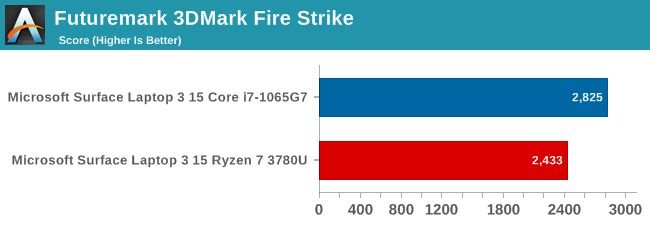
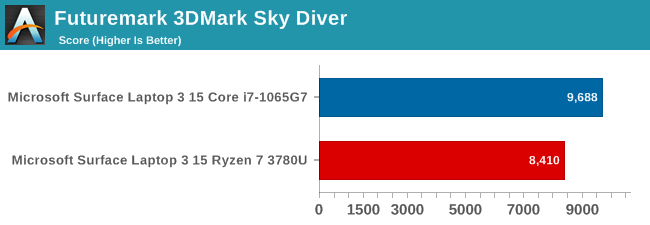
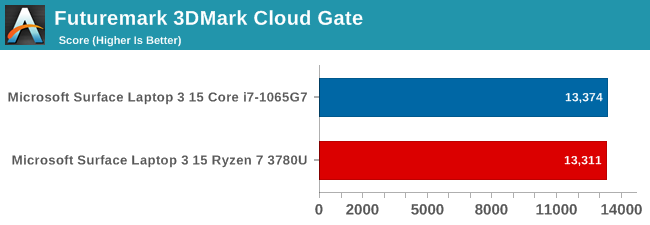
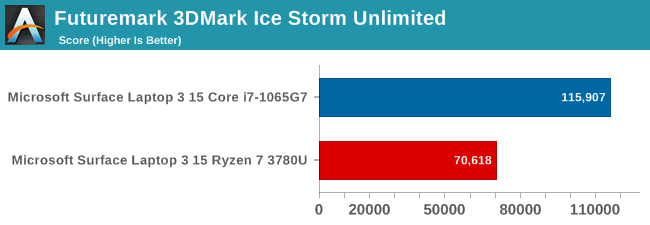
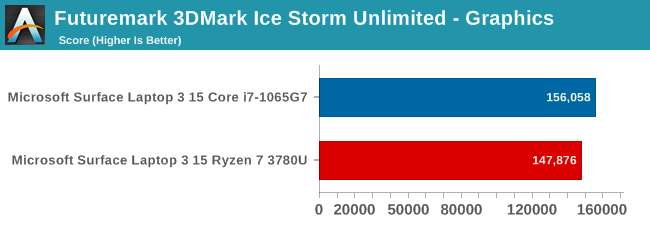
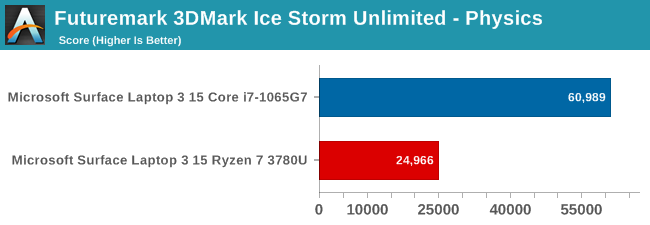
3DMark offers several tests of varying complexity, from Fire Strike as the most demanding, to Ice Storm Unlimited, which can be run on tablets. Here the Ice Lake platform pulls ahead, with better CPU performance helping quite a bit, although the Ice Lake’s Iris Plus graphics is also able to outperform Vega 11 as well.
GFXBench

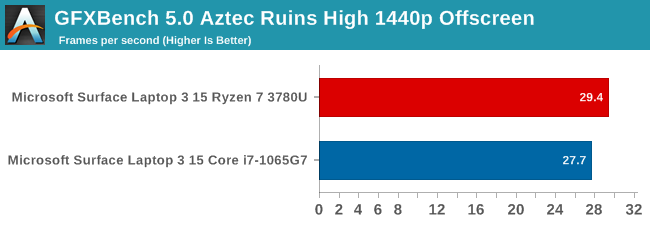
Kishonti’s latest GFXBench suite added DirectX 12 tests to the fold, making it far more relevant than the older OpenGL versions available on the desktop previously. AMD’s previous work in low-level drivers when they developed Mantle has provided the groundwork for DX12 as well, with Vega 11 offering slightly better results than Iris Plus in this test.
Tomb Raider

Running at our value settings, Tomb Raider was easily playable on both systems, with framerates approaching 100 FPS. The Ice Lake platform performed better on this test.
Rise of the Tomb Raider
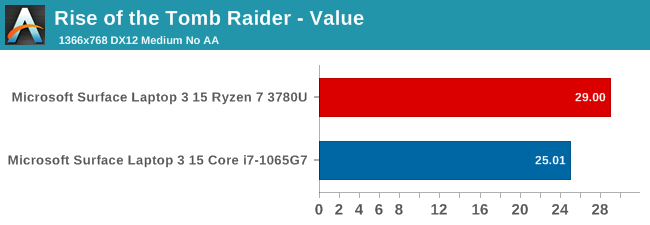
The second installment in the Tomb Raider series offers much more demanding visuals, and both systems struggle to play it at our value settings. The DirectX 12 title performs slightly better on Vega, and with some additional settings tweaks, the game would be playable, which is not something you could have said on an integrated GPU previous to Ryzen and Ice Lake.
Strange Brigade
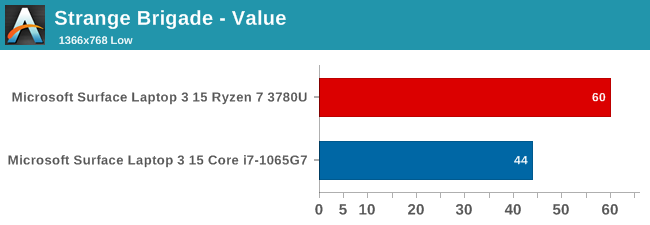
A new title we’re bringing to our laptop suite is Strange Brigade, which scales down nicely on integrated graphics. This game also supports DirectX 12, and as tends to be the pattern, performs very well on Vega 11.
F1 2017
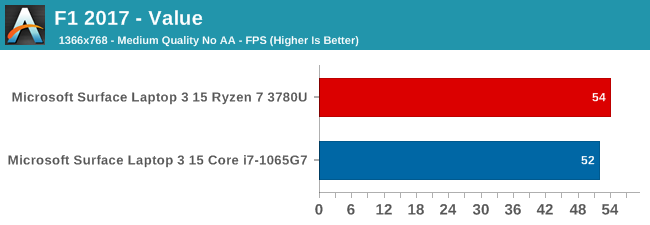
Back with a DirectX 11 title, we see that Intel has again closed the gap, and this game tends to be somewhat CPU bottlenecked as well, so the Sunny Cove cores likely help out here too, but once again Vega 11 wins, if only by a nose.
F1 2019
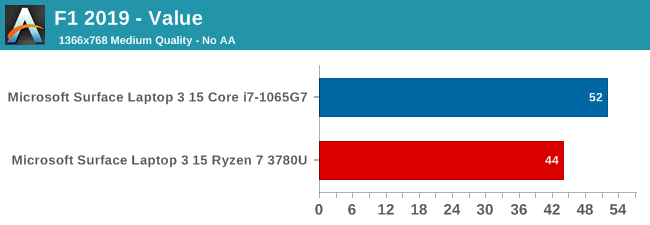
Codemasters updated the underlying EGO engine to support DirectX 12, which was utilized on this test. Despite that, the Vega 11 GPU is a bit slower than the Iris Plus in this test.
Far Cry 5
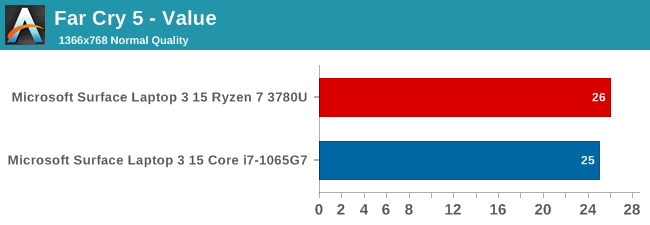
Both systems are within striking distance of being playable, which is somewhat remarkable since the Far Cry series is one of the most popular AAA first-person shooters. The Vega 11 GPU was slightly ahead, which is somewhat surprising as this game tends to be CPU bound, but clearly at this low of a GPU limit that hasn’t come into play yet.










174 Comments
View All Comments
Andrei Frumusanu - Friday, December 13, 2019 - link
Correct. Between 3-5 hours each ST and MT.Fataliity - Friday, December 13, 2019 - link
"despite this being a 3.9 GHz chip, in single-threaded SPEC 2017, it managed to come very close to a 5.0 GHz Core i9-9900K with a massively higher TDP"This statement is contradictory. "Single-Threaded" Spec, then "Massively higher tdp" 9900k is 8 cores. which reflects the TDP. Single-Thread is one core, which is completely different. If you scale up the frequency / wattage graph, a Ice Lake 3.5GHz at 8 cores would be about 100 watts. Which im pretty sure is really close to a 9900k off the top of my head. Except this is at 3.5 and 9900k is hitting 5GHz.
tipoo - Friday, December 13, 2019 - link
Shame AMD didn't have 7nm Zen 2 for mobile ready in time for this. Maybe that's when the partnership will make more sense, until then I wish the consumer 15" was also Ice Lake.s.yu - Friday, December 13, 2019 - link
The difference is too great. This is almost an i3 to i7 comparison, while the price difference is confusingly little. Though the Intel version could be hard to acquire, whoever's interested in this model should aim for the Intel version, even through unofficial channels.eastcoast_pete - Friday, December 13, 2019 - link
Interesting! Guess Chipzilla is (still) king of the hill in mobile; quite impressive, as this IL i7 even comes close to desktop i7 speeds. AMD really needs to get 7 nm Zen2 or Zen2+ into mobile APUs pronto - they're leaving a lot of money on the table. Now is the time, before chipzilla gets their manufacturing problems worked out!MBarton - Monday, December 30, 2019 - link
Less impressive when you consider the amount of money and number of defective CPU's required by Intel fabs to get to this point. When you factor in how much money Intel has dumped into their 10nm process over the last decade the money they're making off of 10 nm is sad.Consumer1 - Friday, December 13, 2019 - link
Interesting to me is the slow speed of the memory with the Ryzen. Ryzen does better with faster memory. To bad we can't equalize the memory to see the effect.Dustin Sklavos - Friday, December 13, 2019 - link
I would never in a million years accuse AnandTech writers of being shills.That said, you guys didn't notice the Ice Lake CPU was being allowed to peak and sustain a solid 8W higher than the Ryzen CPU was?
Yes, even with the higher ceiling on Ice Lake, it's able to bring its idle draw down way lower than Ryzen's, so the bursty nature of garden variety on-battery web surfing is going to heavily favor Ice Lake.
But plugged in, full bore benchmarks, the Ice Lake unit is at a clear advantage for power budget and that's concerning. It's not really as fair a fight when the Ryzen is being kneecapped, and while I don't think it would change the overall results, I *do* think the CPU tests wouldn't be the bloodbath that they are, and the GPU tests (and especially gaming tests) would be a clearer cut win for AMD.
Brett Howse - Saturday, December 14, 2019 - link
I mentioned this in the text but the data logging tool is monitoring CPU core power on Ryzen and SoC package power on Core so the data isn't 100% comparable just due to what each company exposes to be monitored. If you look at the CPU temperatures on the Cinebench R20 test as an example the CPU temperatures are very similar so I don't think the power budget is as far off as you'd think, although Intel is pretty aggressive with boost.Fataliity - Saturday, December 14, 2019 - link
Zen+ APU is also a 216mm die vs Intel's 125mm die. So it has double the surface area, which should mean almost double the heat dissipation (maybe less). So Intel's numbers being twice as high in power draw actually makes sense when you consider the area that is dissipating the heat.